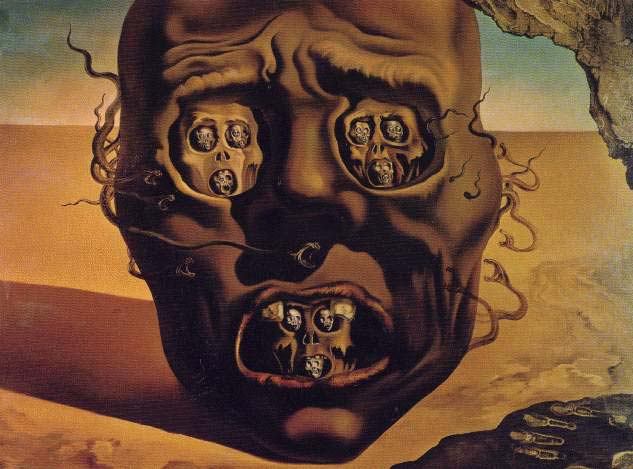| The Face of War | |
|---|---|
 |
|
| Artist | Salvador Dalí |
| Year | 1940 |
| Medium | Oil on canvas |
| Location | Museum Boymans-van Beuningen, Rotterdam |
| Dimensions | 25.2 in × 31.1 in |
| 100 cm × 79 cm | |
| Famous Paintings by Salvador Dalí | |
| The Persistence of Memory, 1931 | |
| The Disintegration of the Persistence of Memory, 1952-1954 | |
| The Face of War, 1940 | |
| The Ecumenical Council, 1960 | |
| Landscape Near Figueras, 1910 | |
| Christ of Saint John of the Cross, 1951 | |
| Lobster Telephone, 1936 | |
| Swans Reflecting Elephants, 1937 | |
| Apparatus and Hand, 1927 | |
| The Discovery of America by Christopher Columbus, 1959 | |
| Morphological Echo, 1934-36 | |
| The First Days of Spring, 1929 |
The famous surrealist painter, Salvador Dalí, gave us several works of art that are considered masterpieces by many. The Face of War is an oil on canvas painting which he produced in 1940, which was a difficult year due to World War II. Salvador Dali was inspired by this traumatic period and painted The Face of War, which essentially depicts a frightening, brownish face, which represents the ugliness of war.
This face is similar to a skull or to the face of a cadaver, and it is seen with a desert landscape as background. In this face’s eye sockets and mouth opening one can see three smaller, similar faces. One can also see many serpents swarming around the face, and a hand print in the lower right corner.
Artistic Techniques
Dali tried to come up with a painting that shows the ugliness of war through surrealism. The brownish colors he used evoke a sense of desperation and misery. The painting also makes one feel sad and frightened when looking into its deeper meaning and its various elements.